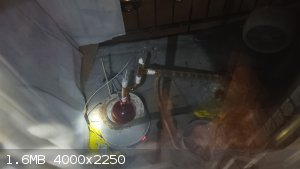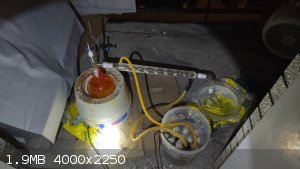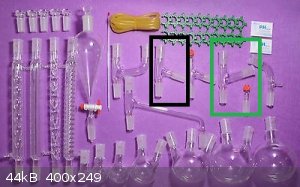| Pages:
1
2
3 |
chornedsnorkack
National Hazard
   
Posts: 563
Registered: 16-2-2012
Member Is Offline
Mood: No Mood
|
|
Not this one. Volume is not conserved on mixing!
|
|
|
ManyInterests
National Hazard
   
Posts: 930
Registered: 19-5-2019
Member Is Offline
|
|
This is my current setup for making nitric acid. I don't see that much nitric acid coming over as compared to the previous times. How long does it
normally take under these circumstances? I hope it isn't too big or letting it come back down or anything...

|
|
|
B(a)P
International Hazard
    
Posts: 1139
Registered: 29-9-2019
Member Is Offline
Mood: Festive
|
|
It depends how cold the surrounding environment is and how strong your heating.
Going slower will lead to less nitrogen dioxide contamination.
When I have done this previously it takes around 15 minutes for the first few drops to come over. At 30 minutes the nitrogen dioxide will have stopped
and I would switch out the receiver, only required if you want WFNA.
The only real concern with regard to distillation rate is the amount of time you have available to supervise the reaction. If you are running short of
time you can consider insulating up to the condenser.
Edit, some questions for clarity
How long has it taken for anything to come over?
How many drips are you currently getting per minute?
[Edited on 31-5-2023 by B(a)P]
|
|
|
ManyInterests
National Hazard
   
Posts: 930
Registered: 19-5-2019
Member Is Offline
|
|
Quote: Originally posted by B(a)P  | It depends how cold the surrounding environment is and how strong your heating.
Going slower will lead to less nitrogen dioxide contamination.
When I have done this previously it takes around 15 minutes for the first few drops to come over. At 30 minutes the nitrogen dioxide will have stopped
and I would switch out the receiver, only required if you want WFNA.
The only real concern with regard to distillation rate is the amount of time you have available to supervise the reaction. If you are running short of
time you can consider insulating up to the condenser.
Edit, some questions for clarity
How long has it taken for anything to come over?
How many drips are you currently getting per minute?
[Edited on 31-5-2023 by B(a)P] |
Yeah, insulation is a must, I haven't gotten much of it. It's been hours and I am kinda tired. I will need to cut this one short for now.
For the questions is I did see some drips at first, but they ceased kinda quickly. For the 2nd question, I don't think I saw anything really drip
over.
The temperature has been very stable at 90C. No changed or fluctuations.
I agree that insulation is needed. What I am going to do is power off my mantle and just leave it there for the night. I'm too tired to dismantle it
and the last thing I want to do is make a mistake due to fatigue.
I set it up that I can unplug the mantle while leaving the water pump going.
I will try to restart again tomorrow, with the same stuff already in the flask, this time not being super iffy with the temp control. When I do again
with fresh reagents I will absolutely wrap everything up in aluminum foil except for the receiving flask and joint so I can see if anything is coming
over.
Nitric acid has been an adventure and this is going to be an even nicer one. I hope I don't get any acid on my self by accident and I hope that by the
end of it I will be able to consistently make WFNA from the get-go without additional distillation.
I will post again tomorrow once I have more to report.
|
|
|
Rainwater
National Hazard
   
Posts: 919
Registered: 22-12-2021
Member Is Offline
Mood: indisposition to activity
|
|
The temperature probe is not located at the very top of the distillation head, could be the problem.
"You can't do that" - challenge accepted
|
|
|
ManyInterests
National Hazard
   
Posts: 930
Registered: 19-5-2019
Member Is Offline
|
|
Given the fact that I got a big fat nothing I am inclined to agree. I had a mishap with the water adapter. The hose somehow got loose from the bucket
sometime overnight. But that didn't do any damage. All the water has long evaporated (and my balcony is a bit cleaner).
Cleaned all the apparatus and next time (tonight) will restart the whole thing with the adapter higher up. The thermoprobe is a tiny little one and I
kept it at the bottom. If moving it up will help I will do that.
I also will need to look for another adapter. Using this setup requires the acid to climb too much. I had another simpler 3-way adapter, but one of
the joints was not what I thought it was. I need to find another that will fit into the condenser so I can give the acid a shorter path to
distillation.
I also kept the water in the water pump bucket VERY cold. Is this appropriate?
|
|
|
Sir_Gawain
Hazard to Others
  
Posts: 420
Registered: 12-10-2022
Location: Due South of Due West
Member Is Offline
Mood: Like a pendulum
|
|
Generally, colder is better. It decomposes less at lower temperatures. I once got it so cold I condensed some nitrogen oxides into a bluish liquid.
“Alchemy is trying to turn things yellow; chemistry is trying to avoid things turning yellow.” -Tom deP.
|
|
|
Rainwater
National Hazard
   
Posts: 919
Registered: 22-12-2021
Member Is Offline
Mood: indisposition to activity
|
|
Nitric acid is not something you want to leave unattended. From personal experience
I was distilling some water (big woop) and left it overnight, what could go wrong.
about 3-4am my smoke alarm is going off, i run down stairs, and see my heating mantle is black, a 1L rbf is melted and cracked.
Turns out, when my boiling flask was empty, the head tempature dropped, so the mantle cranked up the heat. As their was no more water to distille, the
temperature continued to drop and the mantle got hot enough to melt borosilicate glass.
At those tempatures the byproduct KHSO4 will decompose into K2S2O7 which is a strong oxidizer
Now i use a sand bath set to a safe tempature for di water.K2S2O7
Second mishap, the tempature probe fell out. Sand melts aswell.
"You can't do that" - challenge accepted
|
|
|
ManyInterests
National Hazard
   
Posts: 930
Registered: 19-5-2019
Member Is Offline
|
|
Quote: Originally posted by Rainwater  | Nitric acid is not something you want to leave unattended. From personal experience
I was distilling some water (big woop) and left it overnight, what could go wrong.
about 3-4am my smoke alarm is going off, i run down stairs, and see my heating mantle is black, a 1L rbf is melted and cracked.
Turns out, when my boiling flask was empty, the head tempature dropped, so the mantle cranked up the heat. As their was no more water to distille, the
temperature continued to drop and the mantle got hot enough to melt borosilicate glass.
At those tempatures the byproduct KHSO4 will decompose into K2S2O7 which is a strong oxidizer
Now i use a sand bath set to a safe tempature for di water.K2S2O7
Second mishap, the tempature probe fell out. Sand melts aswell.
|
This is why I turned the mantle off. I just left the water pump on. It did have an accident, but not a big one.
|
|
|
Rainwater
National Hazard
   
Posts: 919
Registered: 22-12-2021
Member Is Offline
Mood: indisposition to activity
|
|
If your unable to get the tempature probe into the distillation head, then a sand bath will work. Its much slower but if you distilled to dryness it
ensures your equipment will remain at a non destructive tempature.
Setting it to something around 200c at the start will warm things up and k8ckoff your reaction
Then when distillate starts comming over, then turning it down to whatever tempature it currently reports.
It defeats the purpose of having a PID controlled mantle but at the same time allows experimentation while the proper glassware is obtained
"You can't do that" - challenge accepted
|
|
|
ManyInterests
National Hazard
   
Posts: 930
Registered: 19-5-2019
Member Is Offline
|
|
Quote: Originally posted by Rainwater  | If your unable to get the tempature probe into the distillation head, then a sand bath will work. Its much slower but if you distilled to dryness it
ensures your equipment will remain at a non destructive tempature.
Setting it to something around 200c at the start will warm things up and k8ckoff your reaction
Then when distillate starts comming over, then turning it down to whatever tempature it currently reports.
It defeats the purpose of having a PID controlled mantle but at the same time allows experimentation while the proper glassware is obtained
|
I think I might have gotten a handle on this. I have restarted the distillation with the old stuff. I managed to get a small probe (wrapped securely
in teflon tape to protect it) and placed it at the top of the joint. You can see it in the picture. It's the white thing at the top.
I hope this works. I will observe it closely.

|
|
|
ManyInterests
National Hazard
   
Posts: 930
Registered: 19-5-2019
Member Is Offline
|
|
Ok quick update. This is mostly a dud. I do see some nitric acid, but they are stuck in the alihn columns... I will still give it a bit more at the
93C that I set, but otherwise I will need to wait for the flask to cool down until I can recover the acid and get a fresh flask full of sodium nitrate
and try again.
I was using some freshly made potassium nitrate, which I probably try again. I have some questions regarding the purity of the stuff, but it should
still work for making nitric acid. I do see some... they're in the column, I need to tilt it more next time.
edit: Some mild dripping! progress! 
edit2: So it is still mostly a dud even though I did get something out of it. This probably had a lot to do with the events of last night. But at
least I know I am getting something now, so attempts 2 and 3 should yield better results.
edit3: lots more coming over, but it is at a higher temp than 100C. I fear it might not be WFNA. But I can redistill. I hope.
edit4: OK I am superbly confident this is the azeotrope. the temperature it is coming at is 110 or 113C or so. At least I know it isn't a dud!
Should I lower my probe more to get a better reading and distill over WFNA instead of the azeotope?
[Edited on 1-6-2023 by ManyInterests]
[Edited on 1-6-2023 by ManyInterests]
[Edited on 1-6-2023 by ManyInterests]
[Edited on 1-6-2023 by ManyInterests]
[Edited on 1-6-2023 by ManyInterests]
|
|
|
ManyInterests
National Hazard
   
Posts: 930
Registered: 19-5-2019
Member Is Offline
|
|
Yes, so I got a final yield of just 31ml at 44.58 grams. Giving it a specific gravity of 1.43806. This is around 75% nitric acid. I am not surprised
it is at the upper end of the azeotrope.
Tomorrow I will try to lower the probe a bit more to see if I can get a better reading. Not too much, but just above where the flask starts.
|
|
|
Hey Buddy
Hazard to Others
  
Posts: 431
Registered: 3-11-2020
Location: Bushwhacker Country
Member Is Offline
|
|
This is similar to how I do it. The differences are, I generally prepare from NaNO3/NaHSO4 (because it is cheap). I use a cheap chinese burner with a
ceramic dish on the heating mantle filled with sand, and I put the flask in the sand. The heater is plugged into a high temp thermal relay probe
(cheap one) so the temp can be set at relay and the probe put in the sand which controls on/off for controlling sand bath temp. I use a cheap glass
thermometer in the top of the three way adapter for monitoring distillation temp, and a straight tube condenser. Everything else is basically the
same. I never recoded my yields in the beginning but I I think it is useful to have a little HNO3 record of yields for comparing over time. I usually
do it in a garage with an open door. Over time, it corrodes pretty much everything and anything in the garage within around 40 ft. even with the door
open and a small fan blowing. Metals that are galvanized or coated even with paint dont oxidize from transient nitro fumes as much. I have rusted a
lot of tools doing it like this.
|
|
|
Rainwater
National Hazard
   
Posts: 919
Registered: 22-12-2021
Member Is Offline
Mood: indisposition to activity
|
|
I think you have overestimated thread seal tape, youll need this soon
pt1000 replacement (part)
instruction video(kinda)
"You can't do that" - challenge accepted
|
|
|
ManyInterests
National Hazard
   
Posts: 930
Registered: 19-5-2019
Member Is Offline
|
|
No it isn't that. I attached a picture. The one marked in black is what I THOUGHT I had, the one marked in Green is what I actually had.
I could use a proper thermometer adapter in the former, but I made a mistake and I could not attach my condenser column to it. Once I get my hands on
an adapter like that, it won't be an issue.

|
|
|
ManyInterests
National Hazard
   
Posts: 930
Registered: 19-5-2019
Member Is Offline
|
|
In other news. I am going for a 2nd test run to see if I can get WFNA with the sodium nitrate I made... I think I will end up with another azeotrope.
I am thinking that unless I get that adapter that I marked in black I will have to rely on older methods, as the temperature got up to 115 when I was
getting acid.
But on a good note... I saw no red fumes for the first time, this means I had no wasted anything! Which is great.
Edit: I definitely need that joint! Only got 22.5ml of 81% HNO3. The distillation wasn't even done yet. The temperature control is now my main
adversary. With that joint I can do a lot more.
[Edited on 5-6-2023 by ManyInterests]
|
|
|
| Pages:
1
2
3 |